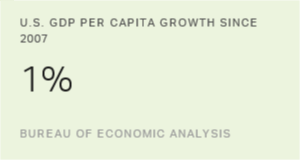WASHINGTON, D.C. -- U.S. unemployment, as measured by Gallup without seasonal adjustment, is 8.1% for the month of August, down slightly from 8.3% measured in mid-August and 8.2% for the month of July. Gallup's seasonally adjusted unemployment rate for August is also 8.1%, a slight uptick from 8.0% at the end of July.

These results are based on Gallup Daily tracking interviews, conducted by landline and cell phone, with more than 30,000 Americans throughout the month. Gallup calculates a seasonally adjusted unemployment rate by applying the adjustment factor the government used for the same month in the previous year. The government adjusted its July numbers downward last year, but made no adjustment in August, which accounts for the increase in seasonally adjusted unemployment despite the decline in the unadjusted number.
U.S. unemployment declined significantly during the first part of the year, but August marks the third straight month with little change in the unadjusted number. Gallup's estimate of adjusted unemployment has increased by 0.3 percentage points since June. Despite the lackluster jobs growth, August's 2012 unadjusted and adjusted unemployment are each more than a full point lower than they were in August 2011.
Underemployment, as measured without seasonal adjustment, was 17.1% in August, unchanged from the end of July but significantly improved from 18.5% a year ago. Gallup's U.S. underemployment measure combines the percentage who are unemployed with the percentage of those working part time but looking for full-time work. Gallup does not apply a seasonal adjustment to underemployment. Demographic breakouts of Gallup's U.S. unemployment and underemployment numbers for August are found on page 2.
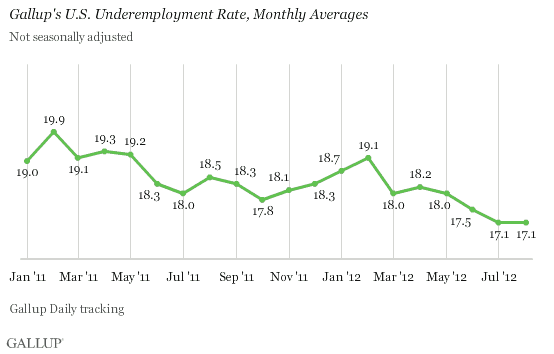
Nine percent of the workforce was employed part time but wanted full-time work during August, little changed from 8.9% at the end of July. The number of part-timers wanting-full time work fluctuates considerably depending on the time of year, which may have to do with part-time seasonal hiring. Although the current reading is down from earlier in the year, it is similar to the 9.3% of a year ago. Gallup does not seasonally adjust the measure on part-timers wanting full-time work.
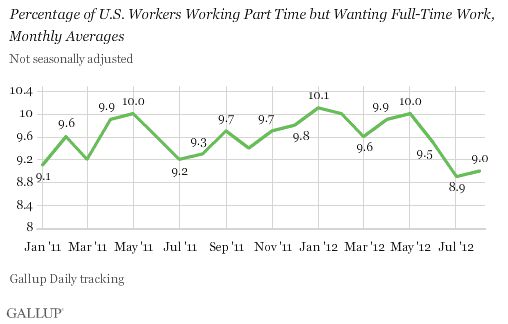
Six in 10 Part-Timers Have No Hope of Finding a Full-Time Job
Although unemployment has been flat over the past three months, Americans are no less hopeful about finding work soon. Forty-six percent of underemployed Americans are hopeful they will find a job in the next four weeks, virtually unchanged from a month ago. Still, a majority of the underemployed are not hopeful they will find work in the next four weeks, and six in 10 part-timers who want to be working full time have no hope they will find a full-time position in that time frame.
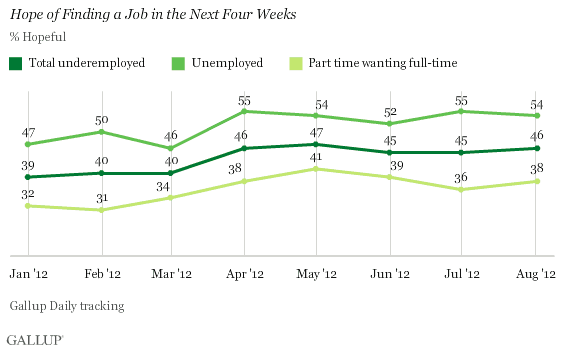
Implications
The decline in unemployment seen earlier in the year has not been sustained, with unadjusted unemployment flat over the past three months. Although there is no longer a net loss of jobs, employers are not adding enough jobs to dramatically reduce the unemployment rate.
Gallup's slight increase in seasonally adjusted unemployment indicates that the unemployment rate the Bureau of Labor Statistics releases on Friday will likely remain flat and possibly increase by a tenth of a point.
Unemployment hovering just above 8.0% could have important implications for President Barack Obama as the election nears. The only incumbent president since 1912 to win his re-election bid when the unemployment rate exceeded 8.0% was Franklin Roosevelt, who was re-elected as the U.S. recovered from the Great Depression. What may matter more, though, is the direction of the unemployment rate, which provides mixed signals for Obama's chances -- improving earlier this year but leveling off in recent months.
Current perceptions of the economy are sharply divided by political party, with Democrats viewing the economy favorably and Republicans maintaining strongly negative economic confidence. This implies that Democrats may view the year-over-year decrease in the unemployment rate as a steady improvement while the economy recovers, but Republicans may perceive any changes in the unemployment situation as too little, too late. Gallup will continue to monitor the economic situation as the election nears.

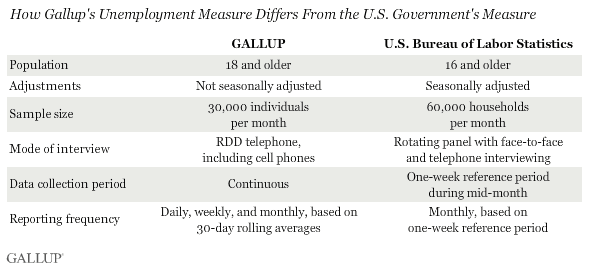
Survey Methods
Results are based on telephone interviews conducted as part of Gallup Daily tracking from August 1-31, 2012, with a random sample of 31,364 adults, aged 18 and older, living in all 50 U.S. states and the District of Columbia, selected using random-digit-dial sampling.
For results based on the total sample of national adults, one can say with 95% confidence that the maximum margin of sampling error is ±1 percentage point.
Interviews are conducted with respondents on landline telephones and cellular phones, with interviews conducted in Spanish for respondents who are primarily Spanish-speaking. Each sample includes a minimum quota of 400 cell phone respondents and 600 landline respondents per 1,000 national adults, with additional minimum quotas among landline respondents by region. Landline telephone numbers are chosen at random among listed telephone numbers. Cell phone numbers are selected using random-digit-dial methods. Landline respondents are chosen at random within each household on the basis of which member had the most recent birthday.
Samples are weighted by gender, age, race, Hispanic ethnicity, education, region, adults in the household, and phone status (cell phone only/landline only/both, cell phone mostly, and having an unlisted landline number). Demographic weighting targets are based on the March 2011 Current Population Survey figures for the aged 18 and older non-institutionalized population living in U.S. telephone households. All reported margins of sampling error include the computed design effects for weighting and sample design.
In addition to sampling error, question wording and practical difficulties in conducting surveys can introduce error or bias into the findings of public opinion polls.
For more details on Gallup's polling methodology, visit www.gallup.com.

